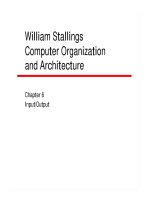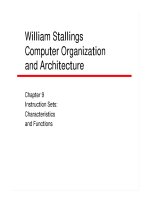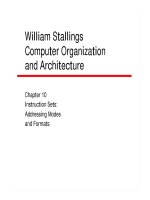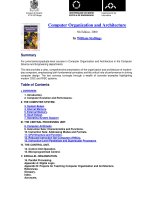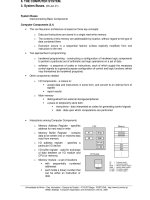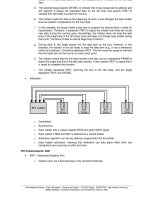Bài giảng Computer Organization and Architecture: Chapter 14
Bạn đang xem bản rút gọn của tài liệu. Xem và tải ngay bản đầy đủ của tài liệu tại đây (424.18 KB, 42 trang )
William Stallings
Computer Organization
and Architecture
6th Edition
Chapter 14
Instruction Level Parallelism
and Superscalar Processors
What is Superscalar?
• Common instructions (arithmetic, load/store,
conditional branch) can be initiated and
executed independently
• Equally applicable to RISC & CISC
• In practice usually RISC
Why Superscalar?
• Most operations are on scalar quantities (see
RISC notes)
• Improve these operations to get an overall
improvement
General Superscalar Organization
Superpipelined
• Many pipeline stages need less than half a clock
cycle
• Double internal clock speed gets two tasks per
external clock cycle
• Superscalar allows parallel fetch execute
Superscalar v
Superpipeline
Limitations
•
•
•
•
Instruction level parallelism
Compiler based optimisation
Hardware techniques
Limited by
—True data dependency
—Procedural dependency
—Resource conflicts
—Output dependency
—Antidependency
True Data Dependency
• ADD r1, r2 (r1 := r1+r2;)
• MOVE r3,r1 (r3 := r1;)
• Can fetch and decode second instruction in
parallel with first
• Can NOT execute second instruction until first is
finished
Procedural Dependency
• Can not execute instructions after a branch in
parallel with instructions before a branch
• Also, if instruction length is not fixed,
instructions have to be decoded to find out how
many fetches are needed
• This prevents simultaneous fetches
Resource Conflict
• Two or more instructions requiring access to the
same resource at the same time
—e.g. two arithmetic instructions
• Can duplicate resources
—e.g. have two arithmetic units
Effect of
Dependencies
Design Issues
• Instruction level parallelism
—Instructions in a sequence are independent
—Execution can be overlapped
—Governed by data and procedural dependency
• Machine Parallelism
—Ability to take advantage of instruction level
parallelism
—Governed by number of parallel pipelines
Instruction Issue Policy
• Order in which instructions are fetched
• Order in which instructions are executed
• Order in which instructions change registers and
memory
In-Order Issue
In-Order Completion
•
•
•
•
Issue instructions in the order they occur
Not very efficient
May fetch >1 instruction
Instructions must stall if necessary
In-Order Issue In-Order Completion (Diagram)
In-Order Issue
Out-of-Order Completion
• Output dependency
—R3:= R3 + R5; (I1)
—R4:= R3 + 1; (I2)
—R3:= R5 + 1; (I3)
—I2 depends on result of I1 data dependency
—If I3 completes before I1, the result from I1 will be
wrong output (readwrite) dependency
In-Order Issue Out-of-Order Completion (Diagram)
Out-of-Order Issue
Out-of-Order Completion
• Decouple decode pipeline from execution
pipeline
• Can continue to fetch and decode until this
pipeline is full
• When a functional unit becomes available an
instruction can be executed
• Since instructions have been decoded,
processor can look ahead
Out-of-Order Issue Out-of-Order Completion
(Diagram)
Antidependency
• Writewrite dependency
—R3:=R3 + R5; (I1)
—R4:=R3 + 1; (I2)
—R3:=R5 + 1; (I3)
—R7:=R3 + R4; (I4)
—I3 can not complete before I2 starts as I2 needs a
value in R3 and I3 changes R3
Register Renaming
• Output and antidependencies occur because
register contents may not reflect the correct
ordering from the program
• May result in a pipeline stall
• Registers allocated dynamically
—i.e. registers are not specifically named
Register Renaming example
•
•
•
•
•
R3b:=R3a + R5a (I1)
R4b:=R3b + 1 (I2)
R3c:=R5a + 1 (I3)
R7b:=R3c + R4b (I4)
Without subscript refers to logical register in
instruction
• With subscript is hardware register allocated
• Note R3a R3b R3c
Machine Parallelism
•
•
•
•
Duplication of Resources
Out of order issue
Renaming
Not worth duplication functions without register
renaming
• Need instruction window large enough (more
than 8)
Branch Prediction
• 80486 fetches both next sequential instruction
after branch and branch target instruction
• Gives two cycle delay if branch taken
RISC - Delayed Branch
• Calculate result of branch before unusable
instructions prefetched
• Always execute single instruction immediately
following branch
• Keeps pipeline full while fetching new instruction
stream
• Not as good for superscalar
—Multiple instructions need to execute in delay slot
—Instruction dependence problems
• Revert to branch prediction

